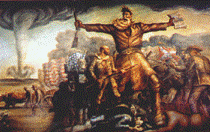History, Department of
Date of this Version
April 2006
Abstract
The Frankfurt Auschwitz trial of 1963 marked the beginning of West Germany’s attempt to confront its horrific past. Auschwitz is one of the most well known of the Nazi concentration camps, in fact, since the fall of the Soviet block, Auschwitz has become one of the preeminent symbols of Holocaust culture, and in large part the 1963 trial in Frankfurt created our current image of it.
Auschwitz was actually a series of three camps, including the labor camps Auschwitz I, housing political prisoners; Auschwitz II, for Jews and Gypsies, and Birkenau, the killing center. Horror permeated Auschwitz like all camps in the Nazi system, gross human rights violations occurred minute by minute.
When West Germany came to confront this grizzly era of its past it was also confronted with terrible irony. West German prosecutors spent years tracking down war criminals, and collecting massive amounts of evidence against them. They then indicted 22 former Auschwitz administrators and guards, intending to place the entire Auschwitz complex on trial, only to be stymied by their own penal code. By attempting to put the Auschwitz system on trial, starting with their 700-page indictment containing a wrenching history of the horrors of Nazi Germany and the camp system, they intended to create an object lesson for Germany and the world—to show that for 12 years ordinary Germans had crossed the line into madness and then melted back into society. I would argue, however, that their lesson got lost in the chaos of the means they had to employ.
Prior to 1959, Nazi war criminals were the province of international courts, and West Germany, still occupied by allied forces, was not able to convene its own legal proceedings. However, the moment the Allies pulled out investigators began collecting evidence in anticipation of a wave of West German trials. The Frankfurt trial was one of the first, and most sensational. The problem of sensation was inevitable. The West German penal code was the same one that had been in operation since the Weimar Republic and did not allow for post-facto prosecution. This meant that prosecutors faced the rather sickening challenge of proving the accused had knowingly, of their own volition, and with base motives violated Nazi-era laws. In doing so, the court unintentionally legitimized the very system that it was attempting to repudiate. Thus, it was not the everyday ordinary horrors of Auschwitz that became the focus of the trial, but the most sensational and macabre. These were what the international media latched on to, even in a more sedate age, and this is what the lesson became. Auschwitz—and by extension the whole Holocaust—were not displayed as actions of ordinary men and women, but as those of sadists who were not remotely “normal.” Thus, an international audience was able to side-step uncomfortable questions, and relate to the Holocaust not as potential perpetrators, but as potential victims. Culpability was reduced to the German population at worst, or a few twisted individuals at best, and the larger implications that West German prosecutors had hoped to raise were subsumed in the details of the German penal code, and the “ordinary” aspect of Nazi criminals was lost in a search for base motives.


Comments
Paper delivered at the 1st Annual James A. Rawley Graduate Conference in the Humanities, Lincoln, NE. April 8, 2006. Copyright © 2006 Shayla Swift.